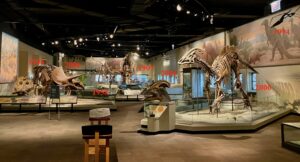What Flying Dinosaurs Are in Jurassic World
In the skies of Jurassic World, not all dragons breathe fire, but some do soar with prehistoric majesty. Among these aerial rulers, the Pteranodon and Dimorphodon are just the tip of the iceberg.
From the giant Quetzalcoatlus to the crested Tapejara, each species presents a unique blend of awe-inspiring traits and behaviors.
Yet, as we explore these sky kings and their kin, a question lingers: how did these creatures dominate the ancient skies, and what can their presence tell us about the ecosystems they inhabited? Uncovering their secrets invites a journey into a world where the line between the past and fantasy blurs.
Key Takeaways
- Jurassic World features pterosaurs like Pteranodon, Dimorphodon, Quetzalcoatlus, and Cearadactylus, showcasing a range of sizes and hunting abilities.
- Adaptations such as specialized beaks and unique wing structures highlight the diverse evolutionary paths of these flying reptiles.
- The film's pterosaurs demonstrate behaviors from dynamic soaring and scavenging to filter feeding, reflecting their ecological niches.
- Ramphorhynchus and Dsungaripterus exhibit unique features for maneuvering and feeding, illustrating the complexity of pterosaur adaptation.
Pteranodon: Sky Kings
Pteranodons, rulers of the prehistoric skies, soared with wingspans exceeding 6 meters, epitomizing aerial dominance during the Late Cretaceous period.
These magnificent creatures weren't true dinosaurs, but rather pterosaurs, a group of flying reptiles that thrived alongside dinosaurs.
Pteranodons distinguished themselves with their long, toothless beaks and massive crests, which varied in shape and size between sexes, suggesting a role in mating displays or aerodynamic function.
Their lightweight bones and large wings allowed them to glide effortlessly over the ancient oceans, hunting for fish.
Scientists believe these creatures employed dynamic soaring, relying on ocean updrafts to maintain flight without constant flapping, showcasing an evolutionary mastery of their environment.
They've captured the public's imagination, often featured in media like 'Jurassic World,' where they're depicted swooping down on unsuspecting prey.
Dimorphodon: Dual-Formed Flyers
Turning our attention to Dimorphodon, we find a pterosaur known for its remarkable wing structure that allowed for skilled aerial maneuvers.
These creatures inhabited coastal regions, where their behavior adapted to both flying and scavenging on land.
Understanding Dimorphodon's unique adaptations sheds light on the diversity and complexity of prehistoric life in the skies of Jurassic World.
Unique Wing Structure
Dimorphodon, a dual-formed flyer, showcased a unique wing structure characterized by a short neck and large head, which set it apart from other pterosaurs. Its anatomy facilitated a distinctive mode of flight. Notably, this pterosaur's wings were supported by:
- A robust fourth finger elongated to support the wing membrane.
- Shorter forelimbs compared to its hind limbs, an unusual trait among flying reptiles.
- A relatively broad wing span that maximized lift in flight.
These anatomical features suggest Dimorphodon was adept at maneuvering through its environment, possibly engaging in burst flights from tree to tree rather than long-distance gliding.
Its unique wing structure underlines the evolutionary diversity among pterosaurs, highlighting their adaptability to various ecological niches.
Habitat and Behavior
Exploring the habitats and behaviors of Dimorphodon reveals a fascinating glimpse into the life of these dual-formed flyers, where they thrived in coastal environments rich in both terrestrial and aquatic food sources. These prehistoric reptiles showcased a remarkable adaptability, nesting in cliffs and foraging along the water's edge. Their diet likely consisted of fish, insects, and small vertebrates, indicating a versatile feeding strategy.
Behavioral evidence suggests that Dimorphodon may have engaged in social activities, possibly hunting in groups or participating in communal nesting practices. This social structure could have played a crucial role in their survival and reproductive success.
The combination of their unique wing structure, explored in the previous subtopic, and their adaptive behaviors underscores the complexity and diversity of life in prehistoric times, offering valuable insights into the evolutionary history of flying reptiles.
Quetzalcoatlus: Giant Gliders
Soaring through the Late Cretaceous skies, Quetzalcoatlus stood out as one of the largest flying creatures ever documented, with a wingspan rivaling that of a small aircraft. This magnificent pterosaur showcases several remarkable features:
- Wingspan: Estimates suggest a wingspan of up to 10-11 meters, making it one of the largest known flying animals.
- Feeding Habits: It's believed to have been a scavenger, using its long beak to pick at carcasses, although some theories suggest it might've also hunted live prey.
- Flight Mechanics: Despite its size, Quetzalcoatlus was an adept flyer. Studies indicate it could launch itself into the air using its strong hind legs and powerful wing muscles, gliding over vast distances to find food or mates.
Understanding Quetzalcoatlus offers insight into the diversity and adaptability of prehistoric life, illustrating how these creatures mastered the skies.
Tapejara: Crested Hunters
While Quetzalcoatlus dominated the late Cretaceous skies with its vast wingspan, Tapejara, a smaller but equally fascinating pterosaur, thrived as a crested hunter, showcasing unique adaptations for survival.
Possessing a prominent cranial crest, Tapejara's headgear likely played a crucial role in thermoregulation, communication, and mating displays. Its wings, though not as expansive as some of its contemporaries, were highly efficient, enabling agile flight patterns that were essential for hunting and evading predators.
Tapejara's beak, sharp and robust, was well-suited for a diet that included fish, small terrestrial vertebrates, and perhaps even carrion. This pterosaur's ability to adapt to varying ecological niches underscores its evolutionary success during the Cretaceous period, marking it as a versatile and resilient member of its ecosystem.
Cearadactylus: Toothed Terror
Amidst the diverse pantheon of Cretaceous pterosaurs, Cearadactylus stood out as a formidable predator, armed with a jaw full of sharp teeth designed for seizing slippery prey. This toothed terror of the skies possessed a unique combination of features that set it apart from its contemporaries:
- Size: Cearadactylus boasted a wingspan that could reach up to 4 meters, making it one of the larger pterosaurs of its time.
- Diet: Primarily fish-eaters, they utilized their teeth to grasp fish tightly, a trait not common among all pterosaurs.
- Habitat: Fossils suggest they thrived in coastal areas, swooping down to snatch fish from the water's surface.
Their presence in Jurassic World adds a layer of authenticity and excitement, showcasing the diversity of prehistoric life.
Ramphorhynchus: Long-Tailed Phenomena
Ramphorhynchus stands out in the Jurassic skies with its distinctive long tail, featuring a diamond-shaped vane at the end. Researchers have examined its hunting habits, revealing a skilled predator of fish and small animals, utilizing its tail for stabilization during flight.
Its habitat, spanning coastal regions, showcases a distribution that capitalized on abundant marine food sources.
Unique Tail Features
The long-tailed Ramphorhynchus stands out for its distinctive caudal appendage, which played a crucial role in its aerial maneuverability. This pterosaur had several unique tail features that contributed to its ability to navigate the skies with precision. The tail was elongated and comprised of bony vertebrae, ending in a diamond-shaped vane. This structure is believed to have functioned as a rudder, helping the creature to steer and stabilize while flying.
Key aspects of the Ramphorhynchus tail include:
- Rigid Structure: Contrary to some other flying reptiles, the tail was stiff due to elongated vertebrae.
- Diamond-shaped Vane: The vane at the tail's end likely served as an aerodynamic stabilizer.
- Steering Mechanism: The tail's flexibility allowed for nuanced control, aiding in abrupt turns and precise landings.
Hunting Habits Explored
Several factors contributed to the Ramphorhynchus's proficiency as a hunter.
One key factor was its unique tail features, which allowed for agile maneuvering in pursuit of prey. The long-tailed pterosaur exhibited a lifestyle predominantly based on fishing, leveraging its ability to swoop down and snatch fish from the water's surface with remarkable precision.
The elongated tail, tipped with a diamond-shaped vane, provided exceptional stability and steering capabilities during flight. This enabled the Ramphorhynchus to make sharp turns and sudden adjustments essential for tracking and capturing fast-moving aquatic targets.
Additionally, its keen eyesight further augmented its hunting efficiency, allowing it to accurately gauge the distance and speed of potential prey. Together, these adaptations made Ramphorhynchus a formidable predator in its aquatic ecosystem.
Habitat and Distribution
Thriving in the Late Jurassic period, long-tailed Ramphorhynchus species predominantly inhabited coastal and nearshore environments, where they adeptly utilized their unique adaptations for hunting. These prehistoric creatures showcased a remarkable ability to thrive in ecosystems that offered abundant resources. Their distribution, primarily around what's now Europe, underscores the adaptability and widespread nature of these flying reptiles.
Key aspects of their habitat included:
- Access to ample fish populations, their primary diet.
- Presence of cliff faces for nesting and refuge.
- Proximity to open waters, facilitating their hunting strategy.
Such environments provided Ramphorhynchus with the necessary conditions for hunting, breeding, and ultimately, survival. Their fossil records, particularly well-preserved in Germany's Solnhofen limestone, offer invaluable insights into their lifestyle and ecological preferences.
Anurognathus: Nighttime Nimrods
Amid the prehistoric night skies, Anurognathus, a diminutive pterosaur, excelled as a nocturnal hunter, employing its acute sensory abilities to locate prey. This small yet agile flyer navigated the darkness with remarkable efficiency, likely relying on enhanced vision and possibly other senses akin to modern nocturnal birds.
Anurognathus boasted a relatively broad wingspan compared to its body size, allowing for quick maneuvers through dense vegetation or tight spaces, crucial for catching insects and other small vertebrates that constituted its diet. The structure of its wings suggests a low-speed flight adapted for sudden changes in direction, an advantage in the cluttered environments it hunted in.
This pterosaur's lifestyle highlights the diverse ecological niches occupied by flying reptiles during the Mesozoic era.
Pterodaustro: Filter-Feeding Fliers
While Anurognathus ruled the night skies, the Pterodaustro genus carved out its own unique ecological niche as specialized filter-feeding fliers during the day. This remarkable creature, thriving in the Cretaceous period, developed a fascinating feeding mechanism to sift through water for food. Its long, slender beak lined with bristle-like structures allowed it to trap small organisms such as crustaceans and plankton.
Key features of Pterodaustro's adaptation include:
- A highly specialized beak: Adapted for filter feeding, akin to modern flamingos.
- Dense, hair-like teeth: These acted as a sieve to capture tiny aquatic prey.
- A lifestyle centered around shallow waters: Where it could easily access its food source.
This distinct feeding strategy highlights the incredible diversity and ecological adaptations among pterosaurs, showcasing the complexity of prehistoric life.
Hatzegopteryx: Titanic Wings
Hatzegopteryx, with its colossal wingspan, dominated the skies of the late Cretaceous period, showcasing an unparalleled mastery of aerial adaptation. This pterosaur, belonging to the azhdarchid family, wasn't just notable for its size but also for its robust physique and distinctive cranial features. Scientists estimate that its wingspan could reach up to 10 meters, making it one of the largest flying animals that ever lived.
Unlike its contemporaries, Hatzegopteryx's wings were supported by a unique structure of hollow, yet incredibly sturdy, bones, enabling it to soar vast distances in search of prey. Its skull, equipped with a powerful beak, was perfectly adapted for seizing and consuming a variety of prey, from small vertebrates to possibly scavenging on carcasses, demonstrating a versatile and opportunistic feeding strategy.
Dsungaripterus: Unique Beak Specialists
Dsungaripterus, a pterosaur from the early Cretaceous period, exhibits highly specialized feeding adaptations that set it apart from its contemporaries. Its unique beak, shaped for cracking hard shells, indicates a diet primarily consisting of crustaceans and mollusks.
Additionally, the pterosaur's distinctive crest features not only contributed to aerodynamics but also may have played a role in mating displays, signaling a complex behavior.
Specialized Feeding Adaptations
Often, the Dsungaripterus is recognized for its distinct beak, a specialized adaptation that allowed it to effectively exploit its ecological niche. This unique beak wasn't merely for show; it was a key tool in the dinosaur's survival strategy. The beak's design provided several advantages:
- Crushing Capability: Its strong, nutcracker-like beak was ideal for crushing hard shells of mollusks and crustaceans, a primary component of its diet.
- Selective Feeding: The beak's shape enabled the Dsungaripterus to selectively pick its food, efficiently consuming only the most nutritious parts.
- Digging Ability: It could use the beak to dig into the sediment, unearthing hidden prey.
These adaptations ensured the Dsungaripterus thrived in its habitat, showcasing evolution's response to dietary needs.
Distinctive Crest Features
Building on its unique feeding adaptations, the Dsungaripterus also boasted distinctive crest features that played crucial roles in its survival and social interactions. The crest, primarily composed of bone, extended upward and backward from the skull, making it one of the most visually striking aspects of this species.
Scientists speculate that these crests weren't just for show; they likely served multiple functions. For one, they could have been used as a display feature to attract mates or assert dominance within their groups, akin to the plumage of some modern birds. Additionally, the crest's aerodynamic properties might've aided in flight, stabilizing the pterosaur during takeoff, gliding, and maneuvers.
This combination of form and function underscores the Dsungaripterus's evolutionary success as a specialized feeder in its ecosystem.
Tropeognathus: Coastal Cruisers
Tropeognathus, known for their expansive wingspans, adeptly navigated the coastal regions in search of food. These prehistoric creatures weren't only masters of the air but also highly adapted to their marine environment. Their diet primarily consisted of fish, which they caught with precision thanks to their specialized features:
- Sharp Beaks: Perfect for snatching prey from the water's surface.
- Wide Wingspans: Allowed for long-duration flights with minimal energy expenditure.
- Keen Eyesight: Essential for spotting fish from high above.
The Tropeognathus' ability to glide effortlessly over the sea, combined with their adept hunting skills, made them formidable coastal cruisers. Their presence in the skies above ancient shorelines was a testament to their evolutionary success in exploiting the abundant resources found in these regions.
Conclusion
In the awe-inspiring skies of Jurassic World, a breathtaking menagerie of flying dinosaurs reigns supreme, each species more astounding than the last. From the majestic Pteranodon, ruling the heavens, to the enigmatic Quetzalcoatlus, whose wings could eclipse the sun, these creatures defy imagination.
With unparalleled adaptations, such as the Dsungaripterus's unique beak and the Pterodaustro's filter-feeding prowess, they showcase evolution's boundless creativity. These sky titans, embodying both beauty and terror, ensure that the skies of Jurassic World remain an unparalleled spectacle, forever capturing the awe of all who dare to look up.




